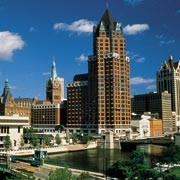Milwaukee’s recent trajectory resembles that of one of its most famous beers: Pabst Blue Ribbon. Both the beer and the city faded a bit as America moved from industrial to post-industrial, but now Milwaukee and Pabst have come roaring back—both surprisingly hip.
Pabst has emerged as the choice of a new generation of urban hipsters, and Milwaukee has just as quickly regained prominence with planners looking for urbane venues without the big-city price tag. And while the city has spent the last couple of decades in a quiet reinvention, it’s now cranking up the volume.
Forget for a moment the 1950s-industrial Milwaukee of Happy Days or Laverne & Shirley and look instead at Santiago Calatrava’s breathtaking Quadracci Pavilion at the Milwaukee Art Museum. Move your gaze on to the brand-new Harley-Davidson Museum. Absorb the Milwaukee Riverwalk’s public art, restaurants and the skyline views. Head indoors to Discovery World, with its aquarium, Great Lakes schooner and tribute to Les Paul—the Waukesha, Wis., native whose Gibson Les Paul guitar inspired millions to turn up the volume on their own.
Asked how the new Milwaukee came to be, Brent Foerster, vice president of sales and marketing at Visit Milwaukee, cites an alliance of far-sighted local politicians and companies who wanted to showcase Milwaukee and break free of a Rust Belt reputation.
“What attracted me here is Milwaukee is investing in the infrastructure of the city for both groups [and individuals], starting 10 years ago with the Midwest Airlines Center,” Foerster says.
Following the Midwest Airlines Convention Center’s opening in 1998, Milwaukee raised its sights even higher when the Santiago Calatrava-designed addition to the Milwaukee Art Museum opened in 2001.
The world-renowned Spanish architect outdid himself with a graceful, jumbo-jet-sized moving sculpture that helped shade the museum—remarkably, this piece’s “wings” fold at night or during bad weather. As a result, the Museum subsequently became Milwaukee’s signature visual.
“The wings are Calatrava, but when you walk into the [museum’s] atrium, it’s rounded glass looking out at the lake, but you’re inside the actual sculpture. And the parking garage is gorgeous. So is the cafeteria. The list goes on and on,” Foerster says.
The Art Museum sits next to Discovery World at Pier Wisconsin, a hands-on, 120,000-square-foot science museum that incorporates the high tech of Milwaukee-area multinational corporations such as Johnson Controls, whose TechnoJungle is a miniature science museum in itself.
This proximity of Milwaukee’s two premier cultural attractions is partly due to a downtown that is remarkably trim for a city of over 600,000, Foerster says.
“It’s very compact, it’s not this sprawling city, and you walk a few blocks and you’re in somewhere completely different,” he says. “The thing that Milwaukee does that separates it from most cities is that, even though it’s clean and easy to get around, they haven’t done that at the cost of history.”
The Potawatomi Casino, in fact, is on the other side of historic Marquette University from downtown, and tripled its size in July 2008.
“There was a combination of local politicians and a lot of the corporations that call Milwaukee home,” Foerster says. “They all said, ‘This is a great city and we have a lot to offer,’ and have invested back into it.”






